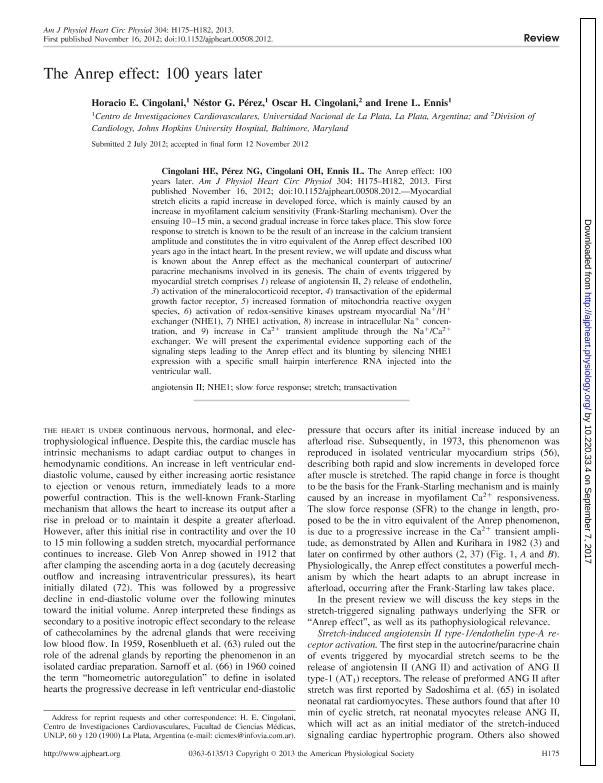Artículo
The Anrep effect: 100 years later
Fecha de publicación:
15/01/2013
Editorial:
American Physiological Society
Revista:
American Journal Of Physiology-heart And Circulatory Physiology
ISSN:
0363-6135
Idioma:
Inglés
Tipo de recurso:
Artículo publicado
Clasificación temática:
Resumen
Cingolani HE, Pérez NG, Cingolani OH, Ennis IL. The Anrep effect: 100 years later. Am J Physiol Heart Circ Physiol 304: H175–H182, 2013. First published November 16, 2012; doi:10.1152/ajpheart.00508.2012.—Myocardial stretch elicits a rapid increase in developed force, which is mainly caused by an increase in myofilament calcium sensitivity (Frank-Starling mechanism). Over the ensuing 10 –15 min, a second gradual increase in force takes place. This slow force response to stretch is known to be the result of an increase in the calcium transient amplitude and constitutes the in vitro equivalent of the Anrep effect described 100 years ago in the intact heart. In the present review, we will update and discuss what is known about the Anrep effect as the mechanical counterpart of autocrine/ paracrine mechanisms involved in its genesis. The chain of events triggered by myocardial stretch comprises 1) release of angiotensin II, 2) release of endothelin, 3) activation of the mineralocorticoid receptor, 4) transactivation of the epidermal growth factor receptor, 5) increased formation of mitochondria reactive oxygen species, 6) activation of redox-sensitive kinases upstream myocardial Na /H exchanger (NHE1), 7) NHE1 activation, 8) increase in intracellular Na concentration, and 9) increase in Ca2 transient amplitude through the Na /Ca2 exchanger. We will present the experimental evidence supporting each of the signaling steps leading to the Anrep effect and its blunting by silencing NHE1 expression with a specific small hairpin interference RNA injected into the ventricular wall.
Palabras clave:
Angiotensin Ii
,
Nhe1
,
Slow Force Response
,
Stretch
,
Transactivation
Archivos asociados
Licencia
Identificadores
Colecciones
Articulos(CIC)
Articulos de CENTRO DE INVEST.CARDIOVASCULARES (I)
Articulos de CENTRO DE INVEST.CARDIOVASCULARES (I)
Citación
Cingolani, Horacio Eugenio; Perez, Nestor Gustavo; Cingolani, Oscar H.; Ennis, Irene Lucia; The Anrep effect: 100 years later; American Physiological Society; American Journal Of Physiology-heart And Circulatory Physiology; 304; 2; 15-1-2013; 175-182
Compartir
Altmétricas




